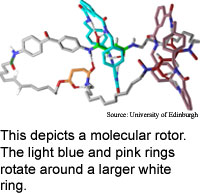
Molecule makes ring rotor
At the size-scale where we live, it takes
a considerable amount of force to get something moving, and keep it moving.
At the molecular scale, however, everything above absolute zero is constantly
moving.
The trick to making nanoscale machines is finding ways to control
this molecular motion.
Researchers from the University of Edinburgh in Scotland have interlocked
large, ring-shaped molecules to make a molecular rotor that moves in only
one direction. The molecule could eventually be used as a nanoscale motor
or winch.
The molecular rotor contains one large ring with two or three small
rings that move around it. Two small rings complete a cycle around four
binding sites on the larger ring during a sequence of six light-driven chemical
reactions. Different wavelengths cause reactions that break the hydrogen
bonds holding one of the two small rings to a site on a larger ring.
The rings are moved one at a time and each time a ring makes a move,
it is forced to move in the direction not blocked by the second ring.
Although the molecular movement during each step happens in a millionth
of a second, the chemical reactions take 5 to 20 minutes each, meaning that
the prototype takes an hour to complete a rotation.
The molecular rotor could be used in practical applications in 10
to 20 years, according to the researchers. The work appeared in the July
10, 2003 issue of Nature.
Skulls gain virtual faces
Viewer explodes virtual buildings
Tool blazes virtual trails
Quantum computer keeps it simple
News briefs:
Video keys off human heat
Interference boosts biochip
Device simulates food
Motion sensor nears quantum limit
Molecule makes ring rotor
Carbon wires expand nano toolkit

Research Watch blog
View from the High Ground Q&A
How It Works
RSS Feeds:
News
Ad links:
Buy an ad link
Ad links: Clear History
Buy an ad link
|
TRN
Newswire and Headline Feeds for Web sites
|
© Copyright Technology Research News, LLC 2000-2010. All rights reserved.